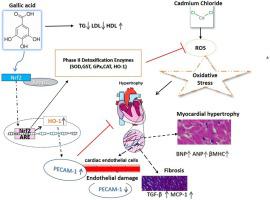Environmental Toxicology and Pharmacology ( IF 4.2 ) Pub Date : 2021-07-06 , DOI: 10.1016/j.etap.2021.103701 Sasikumar Sundaresan 1 , Samu John 2 , Gomathi Paneerselvam 1 , Rathinavel Andiapppan 3 , Godwin Christopher 4 , Govindan Sadasivam Selvam 1

|
Gallic acid (GA) is an abundant natural polyphenolic compound found in vegetable and fruits that reduces the cardiac disease risk factor. This study aims to evaluate GA's role on cadmium (Cd) induced cardiac remodelling in experimental rats. Male Wistar rats were exposed to Cd (15 ppm) in drinking water and administered with GA orally (15 mg/kg/d) for 60 days. The results showed that GA regulated the lipid profile and reduced the LDL to 57 % compared with Cd treated rats. GA inhibited cardiac marker enzymes activity of CK-NAC (to 72.7 %) and CK-MB (to 100.3 %). Moreover, GA attenuated lipid peroxidation and enhanced the cardiac glutathione S transferase (GST) activity (89.2 %), glutathione peroxidase (GPx) (87 %), superoxide dismutase (SOD) (88.4 %) and catalase (CAT) activity (86.5 %). Histopathological examination showed that GA impaired the ventricular hypertrophy and fibrotic proliferation induced by Cd in rats. The combination of GA + Cd, decreased the gene expression of ANP (1-fold), BNP (0.5-fold) and β- MHC (0.9-fold). Furthermore, GA significantly reduced the expression of profibrotic (TGF-β) and proinflammatory (MCP-1) gene in Cd intoxicated rats. GA upregulated the expression of Nrf2 (2-fold), HO-1 (3-fold), and PECAM-1 (0.6-fold), which augments the detoxifying enzyme activity and cellular immunity in Cd intoxicated rats. The increased protein expression of Nrf2, PECAM-1 and decreased AKT-1 levels confirmed the mechanical action of GA during the hypertrophic condition. Thus, our results suggest that GA could act as a potential therapeutic agent regulating Nrf2 and PECAM-1 signalling pathways, thereby ameliorating Cd-induced pathological cardiac remodelling.
中文翻译:

没食子酸通过上调大鼠 Nrf2 和 PECAM-1 信号减弱镉介导的心脏肥厚重塑
没食子酸 (GA) 是蔬菜和水果中含量丰富的天然多酚化合物,可降低心脏病风险因素。本研究旨在评估 GA 对镉 (Cd) 诱导的实验大鼠心脏重塑的作用。雄性 Wistar 大鼠暴露于饮用水中的镉 (15 ppm) 中,并口服 GA (15 mg/kg/d),持续 60 天。结果表明,与 Cd 处理的大鼠相比,GA 调节了血脂状况,并将 LDL 降低至 57%。 GA 抑制 CK-NAC(至 72.7%)和 CK-MB(至 100.3%)的心脏标志酶活性。此外,GA 还能减弱脂质过氧化作用,增强心脏谷胱甘肽 S 转移酶 (GST) 活性 (89.2 %)、谷胱甘肽过氧化物酶 (GPx) (87 %)、超氧化物歧化酶 (SOD) (88.4 %) 和过氧化氢酶 (CAT) 活性 (86.5 %) )。组织病理学检查表明,GA 损害了 Cd 诱导的大鼠心室肥厚和纤维化增殖。 GA + Cd 的组合降低了 ANP(1 倍)、BNP(0.5 倍)和 β-MHC(0.9 倍)的基因表达。此外,GA 显着降低镉中毒大鼠促纤维化 (TGF-β) 和促炎 (MCP-1) 基因的表达。 GA 上调 Nrf2(2 倍)、HO-1(3 倍)和 PECAM-1(0.6 倍)的表达,从而增强镉中毒大鼠的解毒酶活性和细胞免疫。 Nrf2、PECAM-1 蛋白表达增加和 AKT-1 水平降低证实了 GA 在肥厚条件下的机械作用。因此,我们的结果表明,GA 可以作为调节 Nrf2 和 PECAM-1 信号通路的潜在治疗剂,从而改善 Cd 诱导的病理性心脏重塑。











































 京公网安备 11010802027423号
京公网安备 11010802027423号